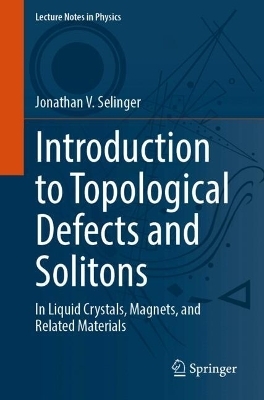
Introduction to Topological Defects and Solitons
Springer International Publishing (Verlag)
978-3-031-70199-3 (ISBN)
This textbook introduces topological defects and solitons at a level suitable for advanced undergraduates and beginning graduate students in physics and materials science. It avoids the formal mathematics of topology, and instead concentrates on the physical properties of these topological structures.
The first half of the book concentrates on fundamental principles of defects and solitons, and illustrates these principles with a single example-the xy model for 2D magnetic order. It begins by defining the concept of a winding number, and uses this concept to describe the topology of defects (vortices or disclinations) and solitons (domain walls), carefully identifying the similarities and differences between these two types of topological structures. It then goes on to discuss physical properties of defects and solitons, including free energy, dynamics, statistical mechanics, and coupling with curvature. It shows how these concepts emerge from a theory with variable magnitude of order, and hence how topology can be viewed as an approximation to physics.
The second half goes on to explore a wider range of topological defects and solitons. First, it considers more complex types of order-2D nematic liquid crystals, 3D magnetic or liquid-crystal order, 2D or 3D crystalline solids-and shows how each type of order leads to specific topological structures. Next, it discusses defects and solitons that are characterized by 2D or 3D measuring surfaces, not just 1D loops, including hedgehogs, skyrmions, and hopfions. These structures are more complex, but they can still be understood using the same fundamental principles. A final chapter describes the formation of phases with regular arrays of defects or solitons.
Jonathan Selinger is Professor of Physics and Ohio Eminent Scholar in Theoretical Liquid Crystal Physics at Kent State University. His research focuses on liquid crystals and other soft materials, and seeks to make connections between fundamental statistical mechanics and technological applications.
Selinger studied physics at Harvard University, receiving his A.B. in 1983 and Ph.D. in 1989. He then did postdoctoral research in Los Angeles, with positions at the UCLA Department of Physics and Caltech Department of Chemical Engineering. In 1992 he moved to the Naval Research Laboratory in Washington, DC, where he worked as Research Physicist in the Center for Bio/Molecular Science and Engineering. In 2005 he came to his current position at Kent State. In addition to these research and teaching positions, he has also served as Associate Editor of Physical Review E, responsible for the liquid-crystal section of the journal, and he is currently Treasurer of the International Liquid Crystal Society.
Selinger's previous book is Introduction to the Theory of Soft Matter: From Ideal Gases to Liquid Crystals, published by Springer in 2016.
Chapter 1. Introduction to Defects.- Chapter 2. Introduction to Solitons.- Chapter 3. Free Energy.- Chapter 4. Dynamics and Statistical Mechanics.- Chapter 5. Prequel to Defects: Variable Magnitude of Order.- Chapter 6. Further Issues: Defect Phase/Orientation, Charge Density, Curvature.- Chapter 7. 2D Nematic Order, Active Liquid Crystals.- Chapter 8. 3D Polar or Nematic Order.- Chapter 9. Defects in Crystals.- Chapter 10. 2D Measuring Surface: Hedgehogs, Skyrmions.- Chapter 11. 3D Measuring Surface: Hopfions.- Chapter 12. Phases With Regular Arrays of Defects or Solitons.
| Erscheinungsdatum | 15.10.2024 |
|---|---|
| Reihe/Serie | Lecture Notes in Physics |
| Zusatzinfo | XIII, 213 p. 80 illus., 77 illus. in color. |
| Verlagsort | Cham |
| Sprache | englisch |
| Maße | 155 x 235 mm |
| Themenwelt | Naturwissenschaften ► Physik / Astronomie ► Atom- / Kern- / Molekularphysik |
| Naturwissenschaften ► Physik / Astronomie ► Festkörperphysik | |
| Schlagworte | Defects in Materials • Disclination defects • Dislocation defects • Hedgehog defects • Hopfions • Skyrmions • Solitons • Topological defects textbook • Topology in materials science • Vortices • Winding number |
| ISBN-10 | 3-031-70199-2 / 3031701992 |
| ISBN-13 | 978-3-031-70199-3 / 9783031701993 |
| Zustand | Neuware |
| Informationen gemäß Produktsicherheitsverordnung (GPSR) | |
| Haben Sie eine Frage zum Produkt? |
aus dem Bereich


